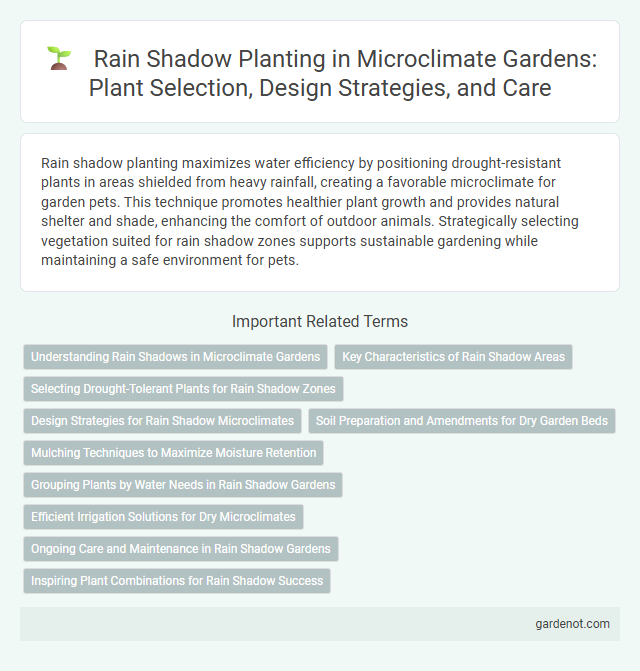Rain shadow planting maximizes water efficiency by positioning drought-resistant plants in areas shielded from heavy rainfall, creating a favorable microclimate for garden pets. This technique promotes healthier plant growth and provides natural shelter and shade, enhancing the comfort of outdoor animals. Strategically selecting vegetation suited for rain shadow zones supports sustainable gardening while maintaining a safe environment for pets.
Understanding Rain Shadows in Microclimate Gardens
Rain shadow planting leverages areas protected from prevailing winds and precipitation to create warmer, drier microclimates ideal for drought-tolerant plants. Understanding rain shadows in microclimate gardens involves recognizing how topography and wind patterns influence moisture distribution, enabling gardeners to select species suited to reduced rainfall zones. This approach optimizes water efficiency and plant health by matching vegetation to specific environmental conditions shaped by natural rain barriers.
Key Characteristics of Rain Shadow Areas
Rain shadow areas experience significantly reduced rainfall due to mountain ranges blocking prevailing winds, resulting in dry, arid conditions ideal for drought-tolerant plants in microclimate gardens. These regions often have intense sunlight, temperature fluctuations, and low humidity, necessitating species adapted to water scarcity and heat stress. Effective rain shadow planting prioritizes native xerophytes and deep-rooted shrubs to optimize water use and soil stability in these unique microclimates.
Selecting Drought-Tolerant Plants for Rain Shadow Zones
Selecting drought-tolerant plants for rain shadow zones ensures thriving garden ecosystems despite limited moisture. Species such as lavender, sage, and yarrow exhibit high resilience to dry conditions, minimizing irrigation needs in microclimate gardens. Incorporating native succulents and deep-rooted perennials optimizes water retention and supports sustainable landscaping in rain shadow microclimates.
Design Strategies for Rain Shadow Microclimates
Rain shadow planting leverages strategic placement of drought-tolerant and heat-resistant plant species to thrive in dry, sheltered microclimates created by natural windbreaks or topography. Incorporating contour planting and mulching enhances soil moisture retention and reduces evaporation in rain shadow areas. Selecting native and deep-rooted vegetation supports ecosystem resilience and optimizes water use efficiency in rain shadow garden designs.
Soil Preparation and Amendments for Dry Garden Beds
For rain shadow planting in dry garden beds, soil preparation must focus on enhancing water retention and nutrient availability through the incorporation of organic matter like compost and well-aged mulch. Adding soil amendments such as gypsum can improve soil structure and drainage, while biochar increases moisture retention and microbial activity. Proper soil testing guides the balanced application of fertilizers and amendments to sustain plant health in these arid microclimate zones.
Mulching Techniques to Maximize Moisture Retention
Mulching techniques in rain shadow planting play a critical role in maximizing moisture retention by reducing soil evaporation and maintaining consistent humidity levels around plant roots. Organic mulches such as straw, wood chips, or compost improve soil structure, enhance microbial activity, and provide insulation against extreme temperature fluctuations. Effective mulching in microclimate gardens minimizes water stress and supports sustainable plant growth in arid, sun-exposed environments.
Grouping Plants by Water Needs in Rain Shadow Gardens
Grouping plants by water needs in rain shadow gardens optimizes irrigation efficiency and promotes healthier growth by ensuring drought-tolerant species receive minimal water while moisture-loving plants get adequate hydration. Strategic placement of xerophytes, such as lavender and sedum, alongside succulents in drier zones enhances water conservation efforts. Incorporating native plants adapted to varying moisture levels within the microclimate reduces maintenance and supports ecosystem resilience.
Efficient Irrigation Solutions for Dry Microclimates
Rain shadow planting optimizes water use by selecting drought-tolerant plants like succulents, native shrubs, and deep-rooted perennials that thrive in dry, sheltered microclimates. Efficient irrigation solutions such as drip irrigation systems and soil moisture sensors reduce water waste by delivering moisture directly to plant roots, promoting healthier growth with minimal evaporation. Mulching and rainwater harvesting further enhance water conservation, maintaining soil humidity and supporting sustainable gardening in arid microclimates.
Ongoing Care and Maintenance in Rain Shadow Gardens
Rain shadow gardens require ongoing care focused on efficient water management, including deep but infrequent irrigation to mimic natural rainfall patterns. Mulching with organic materials conserves moisture and moderates soil temperature, essential in arid microclimates. Regular monitoring for drought stress and timely pruning of drought-tolerant plants optimize growth and sustain garden health in rain shadow conditions.
Inspiring Plant Combinations for Rain Shadow Success
Rain shadow planting thrives by selecting drought-tolerant species like lavender, sage, and yarrow that flourish in dry, sheltered microclimates. Combining deep-rooted perennials with water-wise succulents enhances soil moisture retention and resilience against prolonged dry spells. Incorporating native grasses alongside aromatic herbs creates a diverse, low-water garden ecosystem optimized for rain shadow conditions.
Rain shadow planting Infographic

 gardenot.com
gardenot.com